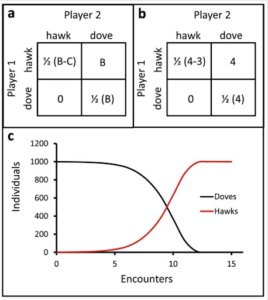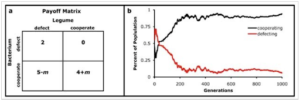Introduction
I am sure most of us have heard of the phrase “survival of the fittest” which was made popular by the famous evolutionist Charles Darwin. The context in which this phrase was used, was about how in nature, animals who were the best adapted to their environment or the most “fit” would be the most successful in surviving. Hence, we can look at adaptation not only from a biological light but also from a behavioural standpoint. As animal species in real life do not live in a vacuum, they are also exposed to other animals of different and the same species and as such are expected to compete for resources and ultimately survival. Each animal needs to decide what strategies to adopt when dealing with different species. These strategies can be illustrated using game theory.
Domination
Take, for example, 2 competing species, a dove and a hawk that fight for the same resources. Let’s say hawks are more prone to violence and like to fight over resources (B) and lose a bit of energy from the fight (C). Doves on the other hand are more cooperative and instead of fighting split the resources. Unfortunately due to the doves’ docile nature when faced with a hawk opt to give up the resources and run. We can model this interaction using a payoff matrix where each player can choose to be either a hawk or a dove. We can see that even if there are initially no very few hawks, more and more players will adopt the hawk strategy as they always win against doves. Eventually leading to an influx of hawks who are likely to fight each other over resources leading to overall fewer resources than if everyone was just a dove. Ultimately showing us that the dove strategy is not viable and will likely not succeed in this environment. This example is a version of the Prisoners’ Dilemma as though both players would be better off being doves, the hawk is the only viable option for both players to guarantee the maximum payout. There are many real-life examples of this situation where invasive species out-compete the local wildlife leading to a drastic decline in the local wildlife population.

Cooperation
So does this tell us that total domination is only the path to survival? Well, not quite there are also other viable strategies like cooperation. These cooperative strategies are based on the assumption that these organisms will interact more than once in their lifetime (which is a lot more realistic) and as such will remember how the opposing organism treated them. For our example, we will define 2 types of interactions either cooperating or defecting. If the benefit of cooperating eventually outweighs the benefits of cheating then the organising will naturally trend towards cooperation. This can be modelled by our payoff matrix below where m is a modifier that is only applied if the organism defected in the previous round and similarly for cooperation. Since organisms are punished sufficiently for defecting and rewarded sufficiently for cooperating the dominant strategy quickly becomes apparent. A real-life example of this is the Egyptian Plover bird and crocodile. The bird would fly into the crocodile’s mouth and eat the debris in its mouth effectively resulting in a meal for the bird and teeth cleaning for the crocodile (reward). The crocodile could very easily eat the bird during this process, but that would result in a loss of mutual trust and hence make the birds less likely to clean the crocodile’s teeth (punishment). Hence the 2 species have come to an understanding to cooperate for mutual benefit. This interaction is commonly known as symbiosis.

Altruism
So we know conditional cooperation works in nature. Now let’s look at another strategy called altruism. Altruism is a strategy whose basis is to help other organisms at the expense of their own immediate fitness. Though this seems counterintuitive, it is also a viable strategy in nature and is mostly seen in animals that display social tendencies like primates. The only caveat is this strategy highly relies on the other organism to reciprocate back altruistic actions. A real-life example is monkeys that make warning calls when predators approach, this hinders the monkey from making the call but helps its tribe. The key is that in the future when other monkeys make a warning call it will benefit. Leading to a net positive result for the whole tribe of monkeys. As you can see here this strategy relies on a lot of trust in the other organisms that will return the favour.
Conclusion
Turns out game theory has various real-life applications including examining various ecosystems. Leveraging this we will be able to better understand the choices of specific species of animals and make predictions on how they will mix when put in the same environment. This knowledge could very easily prove to be useful in many aspects of these animals through conservation and controlling invasive species.
Sources
- Cowden, C. C. (n.d.). Game Theory, Evolutionary Stable Strategies and the Evolution of Biological Interactions. Nature news. Retrieved November 7, 2022, from https://www.nature.com/scitable/knowledge/library/game-theory-evolutionary-stable-strategies-and-the-25953132/
- Symbiosis – causal patterns in science. (n.d.). Retrieved November 7, 2022, from http://www.causalpatterns.org/resources/ecosystems/pdfs/s5_res_symbiosis.pdf
One reply on “The Application of Game Theory to Nature”
Deep and insightful analysis